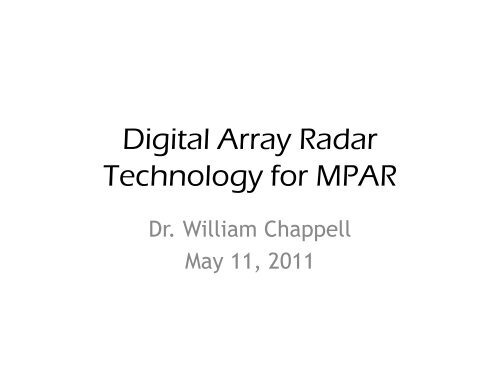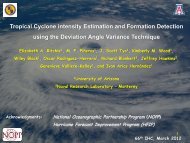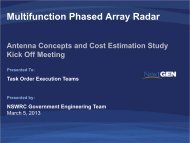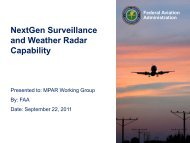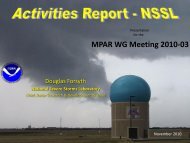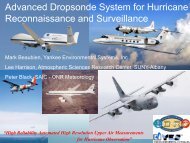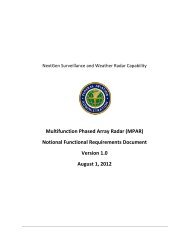Digital Array Radar Technology for MPAR
Digital Array Radar Technology for MPAR
Digital Array Radar Technology for MPAR
Create successful ePaper yourself
Turn your PDF publications into a flip-book with our unique Google optimized e-Paper software.
<strong>Digital</strong> <strong>Array</strong> <strong>Radar</strong><br />
<strong>Technology</strong> <strong>for</strong> <strong>MPAR</strong><br />
Dr. William Chappell<br />
May 11, 2011
Outline<br />
• Introduction to <strong>Digital</strong> <strong>Array</strong> <strong>Technology</strong><br />
– Moore’s Law, Cost, and Per<strong>for</strong>mance<br />
– Standardization and Competition<br />
– Low-Cost RF Frontend Concept<br />
• Army DAR Project<br />
– <strong>Digital</strong> Beam<strong>for</strong>ming and Adaptability<br />
– GaN Antenna Panel Integration<br />
– <strong>Digital</strong> Backend Enhancements<br />
• Dual Polarization Measurements<br />
– Calibration Requirements/ Capabilities<br />
5/2/2011<br />
2
Introduction: <strong>Digital</strong> <strong>Array</strong> <strong>Radar</strong><br />
Past: Passive <strong>Array</strong><br />
Analog<br />
Beam<strong>for</strong>mer<br />
HP<br />
Duplexer<br />
LNA<br />
Tube<br />
Amp<br />
Receiver<br />
and A/D<br />
Wave<strong>for</strong>m<br />
Generator<br />
Processor &<br />
Controller<br />
-Phase shifter/attenuator per element<br />
-Enables fast beam switching<br />
-Losses on both Tx. & Rx.<br />
-Fixed, metal beam<strong>for</strong>mer<br />
-Single points of failure<br />
5/2/2011<br />
Images: W. Weedon, Applied <strong>Radar</strong>, Inc. J. Herd, MIT LL, and S. Kemkemian et. al, Thales, at Phased <strong>Array</strong> Conf., 2010. www.militaryaerospace.com radar.jpl.nasa.gov<br />
3
Introduction: <strong>Digital</strong> <strong>Array</strong> <strong>Radar</strong><br />
Past: Passive <strong>Array</strong><br />
Present: Active <strong>Array</strong> (Digitized Subarray)<br />
Analog<br />
Beam<strong>for</strong>mer<br />
HP<br />
Duplexer<br />
LNA<br />
T/R<br />
T/R<br />
T/R<br />
T/R<br />
T/R<br />
T/R<br />
T/R<br />
T/R<br />
T/R<br />
Analog<br />
BF Analog<br />
BF Analog<br />
BF<br />
-Phase shifter/attenuator per element<br />
-Enables fast beam switching<br />
-Losses on both Tx. & Rx.<br />
-Fixed, metal beam<strong>for</strong>mer<br />
-Single points of failure<br />
5/2/2011<br />
Tube<br />
Amp<br />
Wave<strong>for</strong>m<br />
Generator<br />
Receiver<br />
and A/D<br />
Processor &<br />
Controller<br />
Wave<strong>for</strong>m<br />
Generator(s)<br />
Processor &<br />
Controller<br />
Receivers<br />
and A/D<br />
-LNA, HPA, phase shifter, attenuator,<br />
duplexer, T/R switches per element<br />
-All RF parts handle less power<br />
-Lower RF losses<br />
-More wave<strong>for</strong>m agility<br />
-”Graceful degradation”<br />
-Multiple beams possible w/adaptivity<br />
-Mixing/digitization at subarrays<br />
Images: W. Weedon, Applied <strong>Radar</strong>, Inc. J. Herd, MIT LL, and S. Kemkemian et. al, Thales, at Phased <strong>Array</strong> Conf., 2010. www.militaryaerospace.com radar.jpl.nasa.gov<br />
4
Introduction: <strong>Digital</strong> <strong>Array</strong> <strong>Radar</strong><br />
Past: Passive <strong>Array</strong><br />
Present: Active <strong>Array</strong> (Digitized Subarray)<br />
Analog<br />
Beam<strong>for</strong>mer<br />
HP<br />
Duplexer<br />
LNA<br />
T/R<br />
T/R<br />
T/R<br />
T/R<br />
T/R<br />
T/R<br />
T/R<br />
T/R<br />
T/R<br />
Analog<br />
BF Analog<br />
BF Analog<br />
BF<br />
-Phase shifter/attenuator per element<br />
-Enables fast beam switching<br />
-Losses on both Tx. & Rx.<br />
-Fixed, metal beam<strong>for</strong>mer<br />
-Single points of failure<br />
5/2/2011<br />
Tube<br />
Amp<br />
Wave<strong>for</strong>m<br />
Generator<br />
Receiver<br />
and A/D<br />
Processor &<br />
Controller<br />
Wave<strong>for</strong>m<br />
Generator(s)<br />
Processor &<br />
Controller<br />
Receivers<br />
and A/D<br />
-LNA, HPA, phase shifter, attenuator,<br />
duplexer, T/R switches per element<br />
-All RF parts handle less power<br />
-Lower RF losses<br />
-More wave<strong>for</strong>m agility<br />
-”Graceful degradation”<br />
-Multiple beams possible w/adaptivity<br />
-Mixing/digitization at subarrays<br />
Images: W. Weedon, Applied <strong>Radar</strong>, Inc. J. Herd, MIT LL, and S. Kemkemian et. al, Thales, at Phased <strong>Array</strong> Conf., 2010. www.militaryaerospace.com radar.jpl.nasa.gov<br />
5
Introduction: <strong>Digital</strong> <strong>Array</strong> <strong>Radar</strong><br />
Past: Passive <strong>Array</strong><br />
Present: Active <strong>Array</strong> (Digitized Subarray)<br />
Analog<br />
Beam<strong>for</strong>mer<br />
HP<br />
Duplexer<br />
LNA<br />
T/R<br />
T/R<br />
T/R<br />
T/R<br />
T/R<br />
T/R<br />
T/R<br />
T/R<br />
T/R<br />
Analog<br />
BF Analog<br />
BF Analog<br />
BF<br />
-Phase shifter/attenuator per element<br />
-Enables fast beam switching<br />
-Losses on both Tx. & Rx.<br />
-Fixed, metal beam<strong>for</strong>mer<br />
-Single points of failure<br />
5/2/2011<br />
Tube<br />
Amp<br />
Wave<strong>for</strong>m<br />
Generator<br />
Receiver<br />
and A/D<br />
Processor &<br />
Controller<br />
Wave<strong>for</strong>m<br />
Generator(s)<br />
Processor &<br />
Controller<br />
Receivers<br />
and A/D<br />
-LNA, HPA, phase shifter, attenuator,<br />
duplexer, T/R switches per element<br />
-All RF parts handle less power<br />
-Lower RF losses<br />
-More wave<strong>for</strong>m agility<br />
-”Graceful degradation”<br />
-Multiple beams possible w/adaptivity<br />
-Mixing/digitization at subarrays<br />
Images: W. Weedon, Applied <strong>Radar</strong>, Inc. J. Herd, MIT LL, and S. Kemkemian et. al, Thales, at Phased <strong>Array</strong> Conf., 2010. www.militaryaerospace.com radar.jpl.nasa.gov<br />
6
Introduction: <strong>Digital</strong> <strong>Array</strong> <strong>Radar</strong><br />
Past: Passive <strong>Array</strong><br />
Present: Active <strong>Array</strong> (Digitized Subarray)<br />
Analog<br />
Beam<strong>for</strong>mer<br />
HP<br />
Duplexer<br />
LNA<br />
T/R<br />
T/R<br />
T/R<br />
T/R<br />
T/R<br />
T/R<br />
T/R<br />
T/R<br />
T/R<br />
Analog<br />
BF Analog<br />
BF Analog<br />
BF<br />
-Phase shifter/attenuator per element<br />
-Enables fast beam switching<br />
-Losses on both Tx. & Rx.<br />
-Fixed, metal beam<strong>for</strong>mer<br />
-Single points of failure<br />
5/2/2011<br />
Tube<br />
Amp<br />
Wave<strong>for</strong>m<br />
Generator<br />
Receiver<br />
and A/D<br />
Processor &<br />
Controller<br />
Wave<strong>for</strong>m<br />
Generator(s)<br />
Processor &<br />
Controller<br />
Receivers<br />
and A/D<br />
-LNA, HPA, phase shifter, attenuator,<br />
duplexer, T/R switches per element<br />
-All RF parts handle less power<br />
-Lower RF losses<br />
-More wave<strong>for</strong>m agility<br />
-”Graceful degradation”<br />
-Multiple beams possible w/adaptivity<br />
-Mixing/digitization at subarrays<br />
Images: W. Weedon, Applied <strong>Radar</strong>, Inc. J. Herd, MIT LL, and S. Kemkemian et. al, Thales, at Phased <strong>Array</strong> Conf., 2010. www.militaryaerospace.com radar.jpl.nasa.gov<br />
7
Introduction: <strong>Digital</strong> <strong>Array</strong> <strong>Radar</strong><br />
Past: Passive <strong>Array</strong><br />
Present: Active <strong>Array</strong> (Digitized Subarray)<br />
Analog<br />
Beam<strong>for</strong>mer<br />
HP<br />
Duplexer<br />
LNA<br />
T/R<br />
T/R<br />
T/R<br />
T/R<br />
T/R<br />
T/R<br />
T/R<br />
T/R<br />
T/R<br />
Analog<br />
BF Analog<br />
BF Analog<br />
BF<br />
-Phase shifter/attenuator per element<br />
-Enables fast beam switching<br />
-Losses on both Tx. & Rx.<br />
-Fixed, metal beam<strong>for</strong>mer<br />
-Single points of failure<br />
5/2/2011<br />
Tube<br />
Amp<br />
Wave<strong>for</strong>m<br />
Generator<br />
Receiver<br />
and A/D<br />
Processor &<br />
Controller<br />
Wave<strong>for</strong>m<br />
Generator(s)<br />
Processor &<br />
Controller<br />
Receivers<br />
and A/D<br />
-LNA, HPA, phase shifter, attenuator,<br />
duplexer, T/R switches per element<br />
-All RF parts handle less power<br />
-Lower RF losses<br />
-More wave<strong>for</strong>m agility<br />
-”Graceful degradation”<br />
-Multiple beams possible w/adaptivity<br />
-Mixing/digitization at subarrays<br />
Images: W. Weedon, Applied <strong>Radar</strong>, Inc. J. Herd, MIT LL, and S. Kemkemian et. al, Thales, at Phased <strong>Array</strong> Conf., 2010. www.militaryaerospace.com radar.jpl.nasa.gov<br />
8
Introduction: <strong>Digital</strong> <strong>Array</strong> <strong>Radar</strong><br />
Past: Passive <strong>Array</strong><br />
Present: Active <strong>Array</strong> (Digitized Subarray)<br />
Future/Now: <strong>Digital</strong> <strong>Array</strong><br />
-Phase shifter/attenuator per element<br />
-Enables fast beam switching<br />
-Losses on both Tx. & Rx.<br />
-Fixed, metal beam<strong>for</strong>mer<br />
-Single points of failure<br />
5/2/2011<br />
HP<br />
Duplexer<br />
Tube<br />
Amp<br />
Wave<strong>for</strong>m<br />
Generator<br />
Analog<br />
Beam<strong>for</strong>mer<br />
LNA<br />
Receiver<br />
and A/D<br />
Processor &<br />
Controller<br />
T/R<br />
T/R<br />
T/R<br />
T/R<br />
T/R<br />
T/R<br />
T/R<br />
T/R<br />
T/R<br />
Analog<br />
BF Analog<br />
BF Analog<br />
BF<br />
Wave<strong>for</strong>m<br />
Generator(s)<br />
Processor &<br />
Controller<br />
Receivers<br />
and A/D<br />
-LNA, HPA, phase shifter, attenuator,<br />
duplexer, T/R switches per element<br />
-All RF parts handle less power<br />
-Lower RF losses<br />
-More wave<strong>for</strong>m agility<br />
-”Graceful degradation”<br />
-Multiple beams possible w/adaptivity<br />
-Mixing/digitization at subarrays<br />
T/R<br />
T/R<br />
T/R<br />
T/R<br />
T/R<br />
T/R<br />
T/R<br />
T/R<br />
T/R<br />
Xcvr.<br />
Xcvr.<br />
Xcvr.<br />
Xcvr.<br />
Xcvr.<br />
Xcvr.<br />
Xcvr.<br />
Xcvr.<br />
Xcvr.<br />
A/D+DDS<br />
A/D+DDS<br />
A/D+DDS<br />
A/D+DDS<br />
A/D+DDS<br />
A/D+DDS<br />
A/D+DDS<br />
A/D+DDS<br />
A/D+DDS<br />
<strong>Digital</strong><br />
Backend<br />
Proc. & Controller<br />
-Transceiver, digitizer, and DDS <strong>for</strong><br />
each element<br />
-Multiple beams and adaptive<br />
beam<strong>for</strong>ming limited by I/O and<br />
processing only, not RF hardware<br />
-Ultimate in wave<strong>for</strong>m agility<br />
-High dynamic range potential<br />
-Multiple concurrent functions<br />
Images: W. Weedon, Applied <strong>Radar</strong>, Inc. J. Herd, MIT LL, and S. Kemkemian et. al, Thales, at Phased <strong>Array</strong> Conf., 2010. www.militaryaerospace.com radar.jpl.nasa.gov<br />
9
Introduction: <strong>Digital</strong> <strong>Array</strong> <strong>Radar</strong><br />
Past: Passive <strong>Array</strong><br />
Present: Active <strong>Array</strong> (Digitized Subarray)<br />
Future/Now: <strong>Digital</strong> <strong>Array</strong><br />
-Phase shifter/attenuator per element<br />
-Enables fast beam switching<br />
-Losses on both Tx. & Rx.<br />
-Fixed, metal beam<strong>for</strong>mer<br />
-Single points of failure<br />
5/2/2011<br />
HP<br />
Duplexer<br />
Tube<br />
Amp<br />
Wave<strong>for</strong>m<br />
Generator<br />
Analog<br />
Beam<strong>for</strong>mer<br />
LNA<br />
Receiver<br />
and A/D<br />
Processor &<br />
Controller<br />
T/R<br />
T/R<br />
T/R<br />
T/R<br />
T/R<br />
T/R<br />
T/R<br />
T/R<br />
T/R<br />
Analog<br />
BF Analog<br />
BF Analog<br />
BF<br />
Wave<strong>for</strong>m<br />
Generator(s)<br />
Processor &<br />
Controller<br />
Receivers<br />
and A/D<br />
-LNA, HPA, phase shifter, attenuator,<br />
duplexer, T/R switches per element<br />
-All RF parts handle less power<br />
-Lower RF losses<br />
-More wave<strong>for</strong>m agility<br />
-”Graceful degradation”<br />
-Multiple beams possible w/adaptivity<br />
-Mixing/digitization at subarrays<br />
Advanced<br />
Integration<br />
Difficult to<br />
functionally<br />
“separate”<br />
the sections<br />
T/R<br />
T/R<br />
T/R<br />
T/R<br />
T/R<br />
T/R<br />
T/R<br />
T/R<br />
T/R<br />
Xcvr.<br />
Xcvr.<br />
Xcvr.<br />
Xcvr.<br />
Xcvr.<br />
Xcvr.<br />
Xcvr.<br />
Xcvr.<br />
Xcvr.<br />
A/D+DDS<br />
A/D+DDS<br />
A/D+DDS<br />
A/D+DDS<br />
A/D+DDS<br />
A/D+DDS<br />
A/D+DDS<br />
A/D+DDS<br />
A/D+DDS<br />
<strong>Digital</strong><br />
Backend<br />
Proc. & Controller<br />
-Transceiver, digitizer, and DDS <strong>for</strong><br />
each element<br />
-Multiple beams and adaptive<br />
beam<strong>for</strong>ming limited by I/O and<br />
processing only, not RF hardware<br />
-Ultimate in wave<strong>for</strong>m agility<br />
-High dynamic range potential<br />
-Multiple concurrent functions<br />
Images: W. Weedon, Applied <strong>Radar</strong>, Inc. J. Herd, MIT LL, and S. Kemkemian et. al, Thales, at Phased <strong>Array</strong> Conf., 2010. www.militaryaerospace.com radar.jpl.nasa.gov<br />
10
Introduction: <strong>Digital</strong> <strong>Array</strong> <strong>Radar</strong><br />
Past: Passive <strong>Array</strong><br />
Present: Active <strong>Array</strong> (Digitized Subarray)<br />
Future/Now: <strong>Digital</strong> <strong>Array</strong><br />
-Phase shifter/attenuator per element<br />
-Enables fast beam switching<br />
-Losses on both Tx. & Rx.<br />
-Fixed, metal beam<strong>for</strong>mer<br />
-Single points of failure<br />
5/2/2011<br />
HP<br />
Duplexer<br />
Tube<br />
Amp<br />
Wave<strong>for</strong>m<br />
Generator<br />
Analog<br />
Beam<strong>for</strong>mer<br />
LNA<br />
Receiver<br />
and A/D<br />
Processor &<br />
Controller<br />
T/R<br />
T/R<br />
T/R<br />
T/R<br />
T/R<br />
T/R<br />
T/R<br />
T/R<br />
T/R<br />
Analog<br />
BF Analog<br />
BF Analog<br />
BF<br />
Wave<strong>for</strong>m<br />
Generator(s)<br />
Processor &<br />
Controller<br />
Receivers<br />
and A/D<br />
-LNA, HPA, phase shifter, attenuator,<br />
duplexer, T/R switches per element<br />
-All RF parts handle less power<br />
-Lower RF losses<br />
-More wave<strong>for</strong>m agility<br />
-”Graceful degradation”<br />
-Multiple beams possible w/adaptivity<br />
-Mixing/digitization at subarrays<br />
Advanced<br />
Integration<br />
Difficult to<br />
functionally<br />
“separate”<br />
the sections<br />
T/R<br />
T/R<br />
T/R<br />
T/R<br />
T/R<br />
T/R<br />
T/R<br />
T/R<br />
T/R<br />
Xcvr.<br />
Xcvr.<br />
Xcvr.<br />
Xcvr.<br />
Xcvr.<br />
Xcvr.<br />
Xcvr.<br />
Xcvr.<br />
Xcvr.<br />
A/D+DDS<br />
A/D+DDS<br />
A/D+DDS<br />
A/D+DDS<br />
A/D+DDS<br />
A/D+DDS<br />
A/D+DDS<br />
A/D+DDS<br />
A/D+DDS<br />
<strong>Digital</strong><br />
Backend<br />
Proc. & Controller<br />
-Transceiver, digitizer, and DDS <strong>for</strong><br />
each element<br />
-Multiple beams and adaptive<br />
beam<strong>for</strong>ming limited by I/O and<br />
processing only, not RF hardware<br />
-Ultimate in wave<strong>for</strong>m agility<br />
-High dynamic range potential<br />
-Multiple concurrent functions<br />
Images: W. Weedon, Applied <strong>Radar</strong>, Inc. J. Herd, MIT LL, and S. Kemkemian et. al, Thales, at Phased <strong>Array</strong> Conf., 2010. www.militaryaerospace.com radar.jpl.nasa.gov<br />
11
Future <strong>Digital</strong> <strong>Array</strong>s<br />
• Lower cost<br />
– panelization of RF + digital<br />
– modular/open architecture<br />
– highly-integrated RF with directconversion/low<br />
IF<br />
– surface mount technology and<br />
plastic packaging<br />
• Advanced functionality<br />
– digital at each element<br />
– distributed transceivers<br />
– self-monitoring of errors<br />
– multiple functions<br />
– dual polarization (<strong>MPAR</strong>)<br />
– More I/O and processing BW<br />
5/2/2011<br />
12
Future <strong>Digital</strong> <strong>Array</strong>s<br />
• Lower cost<br />
– panelization of RF + digital<br />
– modular/open architecture<br />
– highly-integrated RF with directconversion/low<br />
IF<br />
– surface mount technology and<br />
plastic packaging<br />
• Advanced functionality<br />
– digital at each element<br />
– distributed transceivers<br />
– self-monitoring of errors<br />
– multiple functions<br />
– dual polarization (<strong>MPAR</strong>)<br />
– More I/O and processing BW<br />
Moore’s Law<br />
5/2/2011<br />
13
Future <strong>Digital</strong> <strong>Array</strong>s<br />
• Lower cost<br />
– panelization of RF + digital<br />
– modular/open architecture<br />
– highly-integrated RF with directconversion/low<br />
IF<br />
– surface mount technology and<br />
plastic packaging<br />
• Advanced functionality<br />
– digital at each element<br />
– distributed transceivers<br />
– self-monitoring of errors<br />
– multiple functions<br />
– dual polarization (<strong>MPAR</strong>)<br />
– More I/O and processing BW<br />
Moore’s Law<br />
Future challenge: Leverage increasing role of digitization to<br />
overcome limitations of lower-cost RF and transceiver functions<br />
5/2/2011<br />
14
<strong>MPAR</strong> Needs<br />
• Programmability<br />
• Low Cost<br />
• Standardization<br />
• Competition<br />
• Dual Pol<br />
5/2/2011
Programmability<br />
T/R<br />
T/R<br />
T/R<br />
T/R<br />
T/R<br />
T/R<br />
T/R<br />
T/R<br />
T/R<br />
T/R<br />
T/R<br />
T/R<br />
T/R<br />
T/R<br />
T/R<br />
T/R<br />
T/R<br />
T/R<br />
Analog<br />
BF Analog<br />
BF Analog<br />
BF<br />
Wave<strong>for</strong>m<br />
Generator(s)<br />
Processor &<br />
Controller<br />
Receivers<br />
and A/D<br />
Xcvr.<br />
Xcvr.<br />
Xcvr.<br />
Xcvr.<br />
Xcvr.<br />
Xcvr.<br />
Xcvr.<br />
Xcvr.<br />
Xcvr.<br />
A/D+DDS<br />
A/D+DDS<br />
A/D+DDS<br />
A/D+DDS<br />
A/D+DDS<br />
A/D+DDS<br />
A/D+DDS<br />
A/D+DDS<br />
A/D+DDS<br />
<strong>Digital</strong><br />
Backend<br />
Proc. & Controller<br />
Software programmability – New beam<strong>for</strong>ming and scan strategies. Dynamic<br />
beam<strong>for</strong>ming capabilities.<br />
Hardware programmability - monthly/yearly adaptability<br />
5/2/2011<br />
16
Cost<br />
• FPGAs subject to the same<br />
implications of Moore’s Law as<br />
other digital circuits<br />
• Per<strong>for</strong>mance and functionality<br />
improvements derived from<br />
increased transistor count<br />
• Current FPGAs achieve needed<br />
functionality with costs reducing<br />
over time<br />
– <strong>Technology</strong> demonstrator at ~$15 per<br />
chip and falling<br />
• Processing technologies provide<br />
ASIC like per<strong>for</strong>mance at a<br />
reduced cost while allowing <strong>for</strong><br />
FPGA prototyping ease<br />
– Xilinx EasyPath<br />
– Altera HardCopy<br />
Xilinx 1 Million System Gate FPGA Cost<br />
5/2/2011<br />
http://www.greentechmedia.com/articles/read/varian-looks-to-en<strong>for</strong>ce-moores-law-in-solar/<br />
http://www.xilinx.com/partners/90nm/<br />
17
Low Cost RF<br />
What has changed in the RF world since I started my career:<br />
1.) RF became a commodity<br />
2.) Full wave electromagnetic analysis became commonplace<br />
3.) Silicon dominates the RF landscape<br />
4.) III-V is starting to be dominated by wideband gap semiconductors<br />
There is the potential <strong>for</strong> RF to be very cheap. For the first time, the RF circuit<br />
is not the domain of the specialist.<br />
5/2/2011<br />
18
What Was State of the Art?<br />
Insert the picture of firsts at ISSCC<br />
Silicon dominates the RF landscape even up to mmWave
Where is the RF in a commercial system?<br />
ifixit.com<br />
The wireless is in the cable<br />
holding down the battery<br />
20
ifixit.com<br />
21
Nearing Commodity Status<br />
Broadcom 4329<br />
65 nm CMOS with built in PA’s. Built in digital wireless stack, CPU, ROM<br />
22
The Challenge <strong>for</strong> a Low Cost <strong>Radar</strong><br />
• The Challenge is too utilize the capability<br />
CMOS and SiGE IC’s which are available.<br />
– Worse per<strong>for</strong>mance but better value<br />
• Can we eliminate the components that make a<br />
radar unique from commercial wireless<br />
systems?<br />
– Phase Shifters, Beam Formers, Circulators/<br />
Isolators, Highly Matched T/R Modules<br />
23
Low-Cost <strong>Array</strong> Concept<br />
Traditional Hybrid <strong>Radar</strong> Module<br />
~<br />
<strong>Digital</strong><br />
Backend<br />
Advanced Integration<br />
A/D<br />
D/A<br />
~<br />
SiGe<br />
GaN<br />
~<br />
Traditional<br />
electronics<br />
Image from Eurofighter’s radar http://www.airpower.at/news06/0922_captor-e/index.html<br />
Massively integrated SiGe<br />
chip transceivers<br />
High power GaN<br />
MMIC<br />
Want low cost integration without sacrificing per<strong>for</strong>mance.<br />
Key technologies are GaN, SiGe, and digital backend integrated<br />
using traditional electronics manufacturing techniques<br />
Planar “laptop-like” integration of modules<br />
and antenna<br />
5/2/2011 19-May-11
Compound Semiconductor Materials on Silicon (COSMOS)<br />
Program Objective: Heterogeneous integration all the way to the transistor scale<br />
• Enable materials selection within circuits – without loss of transistor per<strong>for</strong>mance<br />
• Exploit existing SOA CMOS infrastructure & integration levels – without process modification<br />
DoD Benefits<br />
• Achieve higher functional density: dense integration of analog, mixed-signal, & digital electronics<br />
• Enable circuits with lower dissipated power & far higher I/O throughput<br />
Flip-chip<br />
What else may impact cost?<br />
Today<br />
COSMOS Vision<br />
Reflow solder bumps<br />
Chip size<br />
~1 mm<br />
200 μm pitch<br />
Heterogeneous integration exists only on a very<br />
coarse scale – and not in the signal path<br />
Compound<br />
Semiconductor (CS)<br />
“Chiplets”<br />
Si CMOS<br />
Allow the circuit designer to select the optimal<br />
transistor technology everywhere in the circuit
Xcvr. Header<br />
Xcvr. Header<br />
Xcvr. Header<br />
Xcvr. Header<br />
Xcvr. Header<br />
Header Header<br />
Header Header<br />
Header Header<br />
Header Header<br />
Context <strong>for</strong> Work: Army DAR Project<br />
Vision <strong>for</strong> S-band digital subarray<br />
Initial subarray demonstrator<br />
Control<br />
Quadrant<br />
Transceiver<br />
RF<br />
RS-232<br />
Spartan<br />
3AN<br />
FPGA<br />
32 Mb<br />
SRAM<br />
PC<br />
JTAG<br />
Clock<br />
Dist.<br />
Spartan 2x DAC<br />
Spartan 3A<br />
2x DAC<br />
FPGA<br />
Spartan 3A 2x DAC 2x DAC<br />
FPGA Spartan 3A<br />
2x DAC 2x DAC<br />
FPGA 3A 4x ADC<br />
2x DAC<br />
2x DAC<br />
32 Mb<br />
4x ADC<br />
FPGA<br />
2x DAC<br />
SRAM 32 Mb<br />
4x ADC 2x DAC<br />
SRAM 32 Mb 4x ADC<br />
SRAM 32 Mb<br />
4x ADC<br />
SRAM<br />
2x2<br />
MIMO 2x2<br />
Xcvr. MIMO 2x2<br />
Xcvr. MIMO 2x2<br />
Xcvr. MIMO<br />
Xcvr.<br />
2x2<br />
MIMO 2x2<br />
Xcvr. MIMO 2x2<br />
Xcvr. MIMO 2x2<br />
Xcvr. MIMO<br />
Xcvr.<br />
Sw. GaN<br />
Sw.<br />
Sw.<br />
Sw. GaN Sw.<br />
Sw.<br />
Sw.<br />
Sw. GaN Sw.<br />
Sw.<br />
Sw.<br />
Sw. GaN Sw.<br />
Sw.<br />
Sw.<br />
Sw.<br />
GaN<br />
GaN<br />
GaN<br />
GaN<br />
GaN<br />
GaN<br />
GaN<br />
GaN<br />
GaN<br />
GaN<br />
GaN<br />
GaN<br />
5/2/2011<br />
Five graduate students, two undergraduates, and two faculty<br />
26
Competition<br />
• By decoupling from the central beam<strong>for</strong>mer, the<br />
array subunits could be defined as specs which are<br />
competed.<br />
– Competed at any subunit level (2, 4, 16, 64,… element<br />
panels)<br />
• Connecting together disparate data sources at the<br />
digital data level is a standard process<br />
• Standards dictating the digital data transfer would<br />
allow <strong>for</strong> multiple sources<br />
– Build me the “radiating” laptop with rapid I/O output.<br />
5/2/2011<br />
27
Standardization<br />
Brand Q v1.0<br />
“Radiating Laptop”<br />
Brand X v2.0<br />
“Radiating Laptop”<br />
Standardized Interface<br />
Brand D v1.0<br />
“Radiating Laptop”<br />
Brand Y v2.0<br />
Communication<br />
Network<br />
Brand Y v1.0<br />
Communication<br />
Network<br />
Brand P v5.0<br />
“Radiating Laptop”<br />
Standardized Interface<br />
Brand Z v3.0<br />
“Radiating Laptop”<br />
Brand F v2.0<br />
“Radiating Laptop”<br />
Future Implementations<br />
Fielded Unit<br />
Phased Out<br />
• This could be a parallel to a network implementation of laptop’s/ desktop’s<br />
– Make/ Model / Version of laptop irrelevant as network still functions<br />
• If you build the “radiating laptop” with standards between units, then there is<br />
the possibility of the network parallel being a reality.<br />
5/2/2011<br />
28
Initial DAR Demonstrator<br />
16-Element Backend Stats:<br />
Frequency: 3.1-3.5 GHz<br />
Inst. BW:<br />
Antenna Board:<br />
Antenna Type:<br />
Backend PCBs:<br />
A/D resolution:<br />
Sample rate:<br />
Control Intfc.:<br />
Data Intfc:<br />
Real-time beams:<br />
Element-level RAM:<br />
14 MHz direct conversion<br />
Rogers 4350b & Rohacell<br />
Stacked patch (apt. fed)<br />
FR-4<br />
12 Bits<br />
24 Msps (I/Q)<br />
MATLAB (RS-232)<br />
Gigabit Ethernet<br />
1 (sum/difference)<br />
32 Mb<br />
GaN Panel Stats:<br />
GaN HPA power: 25 W @ 28V per element<br />
GaN HPA PAE: >60%<br />
5/2/2011<br />
29
Initial DAR Demonstrator<br />
Integrated<br />
Ant./RF Panel<br />
5/2/2011<br />
30
Initial DAR Demonstrator<br />
Two Channel<br />
SiGe Transceivers<br />
Integrated<br />
Ant./RF Panel<br />
5/2/2011<br />
31
Initial DAR Demonstrator<br />
Data Conversion/<br />
Processing<br />
Two Channel<br />
SiGe Transceivers<br />
Integrated<br />
Ant./RF Panel<br />
5/2/2011<br />
32
Initial DAR Demonstrator<br />
<strong>Digital</strong> Backend/<br />
PC Interface<br />
Data Conversion/<br />
Processing<br />
Two Channel<br />
SiGe Transceivers<br />
Integrated<br />
Ant./RF Panel<br />
5/2/2011<br />
33
Initial DAR Demonstrator<br />
<strong>Digital</strong> Backend/<br />
PC Interface<br />
Data Conversion/<br />
Processing<br />
Two Channel<br />
SiGe Transceivers<br />
Integrated<br />
Ant./RF Panel<br />
16-Element Backend Stats:<br />
Frequency: 3.1-3.5 GHz<br />
Inst. BW:<br />
Antenna Board:<br />
Antenna Type:<br />
Backend PCBs:<br />
A/D resolution:<br />
Sample rate:<br />
Control Intfc.:<br />
Data Intfc:<br />
Real-time beams:<br />
Element-level RAM:<br />
14 MHz direct conversion<br />
Rogers 4350b & Rohacell<br />
Stacked patch (apt. fed)<br />
FR-4<br />
12 Bits<br />
24 Msps (I/Q)<br />
MATLAB (RS-232)<br />
Gigabit Ethernet<br />
1 (sum/difference)<br />
32 Mb<br />
GaN Panel Stats:<br />
GaN HPA power: 25 W @ 28V per element<br />
GaN HPA PAE: >60%<br />
5/2/2011<br />
34
DAR <strong>Digital</strong> Beam<strong>for</strong>ming<br />
• Verified digital beam<strong>for</strong>ming on Tx. & Rx.<br />
• Measured patterns at Lockheed Martin<br />
5/2/2011<br />
16 elements demonstrated with transmit and receive.<br />
Independent digitization of each transmit and receive channel<br />
35
Army DAR Project <strong>Digital</strong> Backend<br />
• Important features<br />
– <strong>Digital</strong> at every element<br />
– Standard PCB processing<br />
– hierarchical digital<br />
beam<strong>for</strong>mer<br />
– distributed directconversion<br />
transceivers<br />
5/2/2011<br />
36
Army DAR Project <strong>Digital</strong> Backend<br />
• Important features<br />
– <strong>Digital</strong> at every element<br />
– Standard PCB processing<br />
– hierarchical digital<br />
beam<strong>for</strong>mer<br />
– distributed directconversion<br />
transceivers<br />
• Simple example: Bistatic<br />
tracking<br />
5/2/2011<br />
Coupling & clutter<br />
suppression with<br />
element-level data<br />
37
Adaptability<br />
1101101010010…<br />
0110010001011…<br />
• Principle of operation:<br />
– Use receivers as built-in vector signal analyzers<br />
– Monitor transmit-receive coupling pair signals<br />
• Applications:<br />
– <strong>Array</strong> self-calibration and calibration monitoring<br />
– Built-in/automatic I/Q imbalance correction<br />
• Example:<br />
– Denote initial (complex) coupling to n th receiver from the m th transmitter as C mn<br />
– After array has been fielded, make the same recordings (C’ mn ), <strong>for</strong>ming the<br />
matrix K:<br />
C '<br />
mn<br />
T<br />
m<br />
R<br />
n<br />
C<br />
mn<br />
K<br />
mn<br />
C<br />
C<br />
'<br />
mn<br />
mn<br />
T<br />
m<br />
R<br />
n<br />
T m = error from digital signal to V m on Tx.<br />
R n = error from V n to digital signal on Rx.<br />
– Use this matrix to estimate errors in the array (see example )<br />
5/2/2011<br />
38
5/2/2011<br />
Adaptability<br />
39<br />
8<br />
4<br />
7<br />
4<br />
6<br />
4<br />
5<br />
4<br />
4<br />
4<br />
3<br />
4<br />
2<br />
4<br />
1<br />
4<br />
8<br />
3<br />
7<br />
3<br />
6<br />
3<br />
5<br />
3<br />
4<br />
3<br />
3<br />
3<br />
2<br />
3<br />
1<br />
3<br />
8<br />
2<br />
7<br />
2<br />
6<br />
2<br />
5<br />
2<br />
4<br />
2<br />
3<br />
2<br />
2<br />
2<br />
1<br />
2<br />
8<br />
1<br />
7<br />
1<br />
6<br />
1<br />
5<br />
1<br />
4<br />
1<br />
3<br />
1<br />
2<br />
1<br />
1<br />
1<br />
R<br />
T<br />
R<br />
T<br />
R<br />
T<br />
R<br />
T<br />
R<br />
T<br />
R<br />
T<br />
R<br />
T<br />
R<br />
T<br />
R<br />
T<br />
R<br />
T<br />
R<br />
T<br />
R<br />
T<br />
R<br />
T<br />
R<br />
T<br />
R<br />
T<br />
R<br />
T<br />
R<br />
T<br />
R<br />
T<br />
R<br />
T<br />
R<br />
T<br />
R<br />
T<br />
R<br />
T<br />
R<br />
T<br />
R<br />
T<br />
R<br />
T<br />
T R<br />
R<br />
T<br />
T R<br />
R<br />
T<br />
T R<br />
T R<br />
R<br />
T<br />
K
5/2/2011<br />
Adaptability<br />
40<br />
Initial<br />
T = 36C<br />
8<br />
4<br />
7<br />
4<br />
6<br />
4<br />
5<br />
4<br />
4<br />
4<br />
3<br />
4<br />
2<br />
4<br />
1<br />
4<br />
8<br />
3<br />
7<br />
3<br />
6<br />
3<br />
5<br />
3<br />
4<br />
3<br />
3<br />
3<br />
2<br />
3<br />
1<br />
3<br />
8<br />
2<br />
7<br />
2<br />
6<br />
2<br />
5<br />
2<br />
4<br />
2<br />
3<br />
2<br />
2<br />
2<br />
1<br />
2<br />
8<br />
1<br />
7<br />
1<br />
6<br />
1<br />
5<br />
1<br />
4<br />
1<br />
3<br />
1<br />
2<br />
1<br />
1<br />
1<br />
R<br />
T<br />
R<br />
T<br />
R<br />
T<br />
R<br />
T<br />
R<br />
T<br />
R<br />
T<br />
R<br />
T<br />
R<br />
T<br />
R<br />
T<br />
R<br />
T<br />
R<br />
T<br />
R<br />
T<br />
R<br />
T<br />
R<br />
T<br />
R<br />
T<br />
R<br />
T<br />
R<br />
T<br />
R<br />
T<br />
R<br />
T<br />
R<br />
T<br />
R<br />
T<br />
R<br />
T<br />
R<br />
T<br />
R<br />
T<br />
R<br />
T<br />
T R<br />
R<br />
T<br />
T R<br />
R<br />
T<br />
T R<br />
T R<br />
R<br />
T<br />
K
5/2/2011<br />
Adaptability<br />
41<br />
Initial<br />
T = 36C<br />
T = 39C<br />
8<br />
4<br />
7<br />
4<br />
6<br />
4<br />
5<br />
4<br />
4<br />
4<br />
3<br />
4<br />
2<br />
4<br />
1<br />
4<br />
8<br />
3<br />
7<br />
3<br />
6<br />
3<br />
5<br />
3<br />
4<br />
3<br />
3<br />
3<br />
2<br />
3<br />
1<br />
3<br />
8<br />
2<br />
7<br />
2<br />
6<br />
2<br />
5<br />
2<br />
4<br />
2<br />
3<br />
2<br />
2<br />
2<br />
1<br />
2<br />
8<br />
1<br />
7<br />
1<br />
6<br />
1<br />
5<br />
1<br />
4<br />
1<br />
3<br />
1<br />
2<br />
1<br />
1<br />
1<br />
R<br />
T<br />
R<br />
T<br />
R<br />
T<br />
R<br />
T<br />
R<br />
T<br />
R<br />
T<br />
R<br />
T<br />
R<br />
T<br />
R<br />
T<br />
R<br />
T<br />
R<br />
T<br />
R<br />
T<br />
R<br />
T<br />
R<br />
T<br />
R<br />
T<br />
R<br />
T<br />
R<br />
T<br />
R<br />
T<br />
R<br />
T<br />
R<br />
T<br />
R<br />
T<br />
R<br />
T<br />
R<br />
T<br />
R<br />
T<br />
R<br />
T<br />
T R<br />
R<br />
T<br />
T R<br />
R<br />
T<br />
T R<br />
T R<br />
R<br />
T<br />
K
5/2/2011<br />
Adaptability<br />
42<br />
Initial<br />
T = 36C T = 39C T = 45C<br />
8<br />
4<br />
7<br />
4<br />
6<br />
4<br />
5<br />
4<br />
4<br />
4<br />
3<br />
4<br />
2<br />
4<br />
1<br />
4<br />
8<br />
3<br />
7<br />
3<br />
6<br />
3<br />
5<br />
3<br />
4<br />
3<br />
3<br />
3<br />
2<br />
3<br />
1<br />
3<br />
8<br />
2<br />
7<br />
2<br />
6<br />
2<br />
5<br />
2<br />
4<br />
2<br />
3<br />
2<br />
2<br />
2<br />
1<br />
2<br />
8<br />
1<br />
7<br />
1<br />
6<br />
1<br />
5<br />
1<br />
4<br />
1<br />
3<br />
1<br />
2<br />
1<br />
1<br />
1<br />
R<br />
T<br />
R<br />
T<br />
R<br />
T<br />
R<br />
T<br />
R<br />
T<br />
R<br />
T<br />
R<br />
T<br />
R<br />
T<br />
R<br />
T<br />
R<br />
T<br />
R<br />
T<br />
R<br />
T<br />
R<br />
T<br />
R<br />
T<br />
R<br />
T<br />
R<br />
T<br />
R<br />
T<br />
R<br />
T<br />
R<br />
T<br />
R<br />
T<br />
R<br />
T<br />
R<br />
T<br />
R<br />
T<br />
R<br />
T<br />
R<br />
T<br />
T R<br />
R<br />
T<br />
T R<br />
R<br />
T<br />
T R<br />
T R<br />
R<br />
T<br />
K
Adaptability<br />
K<br />
T R<br />
T<br />
T<br />
1<br />
2<br />
3<br />
4<br />
R<br />
1<br />
1<br />
T R<br />
R<br />
1<br />
1<br />
T R<br />
T<br />
T<br />
1<br />
2<br />
3<br />
4<br />
R<br />
2<br />
T R<br />
R<br />
2<br />
2<br />
2<br />
T R<br />
T<br />
T<br />
1<br />
2<br />
3<br />
4<br />
R<br />
3<br />
T R<br />
R<br />
3<br />
3<br />
3<br />
T R<br />
T<br />
T<br />
1<br />
2<br />
3<br />
4<br />
R<br />
4<br />
T R<br />
R<br />
4<br />
4<br />
4<br />
T R<br />
T<br />
T<br />
1<br />
2<br />
3<br />
4<br />
R<br />
R<br />
5<br />
T R<br />
5<br />
5<br />
5<br />
T R<br />
T<br />
T<br />
1<br />
2<br />
3<br />
4<br />
R<br />
R<br />
6<br />
T R<br />
6<br />
6<br />
6<br />
T R<br />
T<br />
T<br />
1<br />
2<br />
3<br />
4<br />
R<br />
R<br />
7<br />
T R<br />
7<br />
7<br />
7<br />
T R<br />
T<br />
T<br />
1<br />
2<br />
3<br />
4<br />
R<br />
R<br />
8<br />
8<br />
T R<br />
8<br />
8<br />
Initial<br />
Final<br />
5/2/2011<br />
T = 36C T = 39C T = 45C T = 50C<br />
43
Adaptability<br />
K<br />
T R<br />
T<br />
T<br />
1<br />
2<br />
3<br />
4<br />
R<br />
1<br />
1<br />
T R<br />
R<br />
1<br />
1<br />
T R<br />
T<br />
T<br />
1<br />
2<br />
3<br />
4<br />
R<br />
2<br />
T R<br />
R<br />
2<br />
2<br />
2<br />
T R<br />
T<br />
T<br />
1<br />
2<br />
3<br />
4<br />
R<br />
3<br />
T R<br />
R<br />
3<br />
3<br />
3<br />
T R<br />
T<br />
T<br />
1<br />
2<br />
3<br />
4<br />
R<br />
4<br />
T R<br />
R<br />
4<br />
4<br />
4<br />
T R<br />
T<br />
T<br />
1<br />
2<br />
3<br />
4<br />
R<br />
R<br />
5<br />
T R<br />
5<br />
5<br />
5<br />
T R<br />
T<br />
T<br />
1<br />
2<br />
3<br />
4<br />
R<br />
R<br />
6<br />
T R<br />
6<br />
6<br />
6<br />
T R<br />
T<br />
T<br />
1<br />
2<br />
3<br />
4<br />
R<br />
R<br />
7<br />
T R<br />
7<br />
7<br />
7<br />
T R<br />
T<br />
T<br />
1<br />
2<br />
3<br />
4<br />
R<br />
R<br />
8<br />
8<br />
T R<br />
8<br />
8<br />
Initial<br />
Final<br />
<strong>Radar</strong> can self-correct <strong>for</strong><br />
environmental stresses<br />
Tx: +/- 5 deg. & 0.13 dB<br />
Rx: +/- 2.0 deg. & 0.2 dB<br />
5/2/2011<br />
T = 36C T = 39C T = 45C T = 50C<br />
44
Xcvr. Header<br />
Xcvr. Header<br />
Xcvr. Header<br />
Xcvr. Header<br />
Xcvr. Header<br />
Header Header<br />
Header Header<br />
Header Header<br />
Header Header<br />
Adaptability<br />
Contro<br />
l<br />
RS-232<br />
Spartan<br />
3AN<br />
FPGA<br />
32 Mb<br />
SRAM<br />
PC<br />
JTAG<br />
Clock<br />
Dist.<br />
Quadrant<br />
Spartan 2x DAC<br />
Spartan 3A<br />
2x DAC<br />
Spartan 2x DAC<br />
FPGA 3A<br />
2x DAC<br />
2x DAC<br />
FPGA<br />
Spartan 3A<br />
2x DAC<br />
4x ADC<br />
2x DAC<br />
FPGA 3A<br />
2x DAC<br />
32 Mb<br />
4x ADC 2x DAC<br />
FPGA<br />
SRAM 32 Mb<br />
4x ADC 2x DAC<br />
SRAM 32 Mb 4x ADC<br />
4x ADC<br />
SRAM 32 Mb<br />
SRAM<br />
Transceiver<br />
2x2<br />
MIMO 2x2<br />
Xcvr. MIMO 2x2<br />
Xcvr. MIMO 2x2<br />
Xcvr. MIMO<br />
Xcvr.<br />
2x2<br />
MIMO 2x2<br />
Xcvr. MIMO 2x2<br />
Xcvr. MIMO 2x2<br />
Xcvr. MIMO<br />
Xcvr.<br />
RF<br />
Sw. GaN<br />
Sw.<br />
Sw.<br />
Sw. GaN Sw.<br />
Sw.<br />
Sw.<br />
Sw. GaN Sw.<br />
Sw.<br />
Sw.<br />
Sw. GaN Sw.<br />
Sw.<br />
Sw.<br />
Sw.<br />
GaN<br />
GaN<br />
GaN<br />
GaN<br />
GaN<br />
GaN<br />
GaN<br />
GaN<br />
GaN<br />
GaN<br />
GaN<br />
GaN<br />
Final<br />
Matrix Rotation to compensate <strong>for</strong><br />
phase and amplitude<br />
Beam<strong>for</strong>ming<br />
(Sum and Difference)<br />
5/2/2011<br />
T = 50C
I/Q Imbalance Self-Correction<br />
• Automated I/Q compensation<br />
0<br />
-20<br />
Rx. Calibration <strong>for</strong> channel 1, board 1<br />
Be<strong>for</strong>e Cal.<br />
After Cal.<br />
0<br />
-20<br />
Rx. Calibration <strong>for</strong> channel 2, board 1<br />
Be<strong>for</strong>e Cal.<br />
After Cal.<br />
-40<br />
-40<br />
-60<br />
-60<br />
-80<br />
-80<br />
-100<br />
-100<br />
-120<br />
-10 -5 0 5 10<br />
freq, MHz<br />
-120<br />
-10 -5 0 5 10<br />
freq, MHz<br />
0<br />
0<br />
• Demonstrates ~10log(N) improvement at beam<br />
Be<strong>for</strong>e Cal.<br />
Be<strong>for</strong>e Cal.<br />
After Cal.<br />
-20<br />
After Cal.<br />
peak<br />
-20<br />
-40<br />
• Enables use of low-cost components<br />
-60<br />
5/2/2011<br />
Rx. Calibration <strong>for</strong> channel 3, board 1<br />
-40<br />
-60<br />
Rx. Calibration <strong>for</strong> channel 4, board 1<br />
46
Xcvr. Header<br />
Xcvr. Header<br />
Xcvr. Header<br />
Xcvr. Header<br />
Xcvr. Header<br />
Header Header<br />
Header Header<br />
Header Header<br />
Header Header<br />
Adaptability<br />
Contro<br />
l<br />
RS-232<br />
Spartan<br />
3AN<br />
FPGA<br />
32 Mb<br />
SRAM<br />
PC<br />
JTAG<br />
Clock<br />
Dist.<br />
Quadrant<br />
Spartan 2x DAC<br />
Spartan 3A<br />
2x DAC<br />
Spartan 2x DAC<br />
FPGA 3A<br />
2x DAC<br />
2x DAC<br />
FPGA<br />
Spartan 3A<br />
2x DAC<br />
4x ADC<br />
2x DAC<br />
FPGA 3A<br />
2x DAC<br />
32 Mb<br />
4x ADC 2x DAC<br />
FPGA<br />
SRAM 32 Mb<br />
4x ADC 2x DAC<br />
SRAM 32 Mb 4x ADC<br />
4x ADC<br />
SRAM 32 Mb<br />
SRAM<br />
Transceiver<br />
2x2<br />
MIMO 2x2<br />
Xcvr. MIMO 2x2<br />
Xcvr. MIMO 2x2<br />
Xcvr. MIMO<br />
Xcvr.<br />
2x2<br />
MIMO 2x2<br />
Xcvr. MIMO 2x2<br />
Xcvr. MIMO 2x2<br />
Xcvr. MIMO<br />
Xcvr.<br />
RF<br />
Sw. GaN<br />
Sw.<br />
Sw.<br />
Sw. GaN Sw.<br />
Sw.<br />
Sw.<br />
Sw. GaN Sw.<br />
Sw.<br />
Sw.<br />
Sw. GaN Sw.<br />
Sw.<br />
Sw.<br />
Sw.<br />
GaN<br />
GaN<br />
GaN<br />
GaN<br />
GaN<br />
GaN<br />
GaN<br />
GaN<br />
GaN<br />
GaN<br />
GaN<br />
GaN<br />
5/2/2011<br />
Matrix Rotation to compensate<br />
<strong>for</strong> phase and amplitude<br />
DC subtraction<br />
I/Q imbalance<br />
Beam<strong>for</strong>ming<br />
(Sum and Difference)<br />
I'<br />
n<br />
Q'<br />
n<br />
A<br />
I<br />
n<br />
Q n<br />
I<br />
Q<br />
DC<br />
DC<br />
B<br />
I<br />
n<br />
Q n<br />
1<br />
1<br />
I<br />
Q<br />
DC<br />
DC<br />
0<br />
-20<br />
-40<br />
-60<br />
-80<br />
-100<br />
-120<br />
Rx. Calibration <strong>for</strong> channel 1, board 1<br />
Be<strong>for</strong>e Cal.<br />
After Cal.<br />
-10 -5 0 5 10<br />
freq, MHz
Transceiver Block Diagrams<br />
Current implementation<br />
Massive integration has<br />
taken place and promises<br />
to further consume<br />
components<br />
Currently available<br />
5/2/2011<br />
http://www.analog.com/static/imported-files/data_sheets/AD9357.pdf<br />
48
GaN HPA Integration on RF Antenna Panel<br />
Package is flip-chip bonded<br />
to multilayer panel<br />
Heat sink is attached here<br />
after reflowing package<br />
Antenna<br />
ground plane<br />
Rogers 4350 Package:<br />
-QFN-like design<br />
- < 0.2 dB loss<br />
- R th < 4ºC/W to heat sink<br />
Measured Packaged Per<strong>for</strong>mance (25<br />
W)<br />
Heat<br />
Signal<br />
High per<strong>for</strong>mance maintained in plastic<br />
package with limited cooling<br />
5/2/2011<br />
49
GaN HPA Integration on RF Antenna Panel<br />
Circulator<br />
Antenna<br />
feed<br />
LNA biasing<br />
GaN package<br />
RF switch<br />
HPA biasing<br />
SMA<br />
Package designed <strong>for</strong> GaN HPA/LNA<br />
combination MMIC integrated into Rogers 4350b<br />
PCB panel<br />
• 51W radiated, 42% efficient overall, 72°C on fancooled<br />
copper slug. 58.8W output into circulator<br />
@ 49% efficiency with 40V drain<br />
• 28W radiated, 40% efficient overall, 52.5°C on<br />
fan- cooled copper slug. 32.3W output into<br />
circulator @ 46% efficiency with 28V drain<br />
5/2/2011<br />
50
DAR Polarimetric Testbed<br />
V<br />
H<br />
• Aperture-coupled, stacked-patch antenna used <strong>for</strong> case study and tests<br />
– Designed <strong>for</strong> broadside cross-pol & port-to-port isolation (> -35 dB)<br />
– Lightweight, panelized, and has wide bandwidth (~3-3.6 GHz)<br />
– Rogers 4350b feed with Rogers 5880LZ top patch substrate<br />
– Similar to other proposed elements <strong>for</strong> <strong>MPAR</strong> (MIT LL/MaCom)<br />
5/2/2011<br />
51
DAR Polarimetric Testbed<br />
V<br />
H<br />
• Aperture-coupled, stacked-patch antenna used <strong>for</strong> case study and tests<br />
– Designed <strong>for</strong> broadside cross-pol & port-to-port isolation (> -35 dB)<br />
– Lightweight, panelized, and has wide bandwidth (~3-3.6 GHz)<br />
– Rogers 4350b feed with Rogers 5880LZ top patch substrate<br />
– Similar to other proposed elements <strong>for</strong> <strong>MPAR</strong> (MIT LL/MaCom)<br />
• Investigations:<br />
– Bi-static scattering analysis and pattern measurement<br />
– Large array simulations<br />
5/2/2011<br />
52
Scattering Demonstration<br />
45°<br />
Tx<br />
Rx<br />
Calibration procedure per<strong>for</strong>med <strong>for</strong> bistatic<br />
setup shown on the left<br />
Flat copper sheet used <strong>for</strong> transmit<br />
reflection calibration S = I<br />
C T and C R matrices determined at:<br />
(AZ,EL) = (35,17) deg.<br />
(AZ,EL) = (-32,22) deg.<br />
Both have noticeable polarization issues<br />
Overall Procedure<br />
1) Per<strong>for</strong>m calibration & compensation of Tx. & Rx.<br />
subarrays at angles of interest<br />
2) Remove compensation and place new target at<br />
one of those locations<br />
3) Send out sequential H and V, 14 MHz wide LFM<br />
chirp wave<strong>for</strong>ms, subtract off (known) mutual<br />
coupling, and demodulate returns<br />
4) Apply digital compensation and repeat (2-3) <strong>for</strong><br />
other targets/angles<br />
5/2/2011<br />
45°<br />
53
Scattering Demo Initial Results<br />
1.18<br />
0<br />
0.20<br />
29<br />
0.99<br />
0<br />
.21<br />
221<br />
C T<br />
0.14<br />
179<br />
0.97<br />
16<br />
C R<br />
.16<br />
15<br />
1.0<br />
18<br />
S<br />
S s<br />
1<br />
0<br />
0<br />
1<br />
5/2/2011<br />
54
Scattering Demo Initial Results<br />
C T<br />
1.18<br />
0.14<br />
0<br />
179<br />
0.20<br />
0.97<br />
29<br />
16<br />
C R<br />
0.99<br />
.16<br />
0<br />
15<br />
.21<br />
1.0<br />
221<br />
18<br />
S<br />
S s<br />
1<br />
0<br />
0<br />
1<br />
S<br />
2<br />
cos / 4 cos / 4 sin / 4 1<br />
S d<br />
S<br />
2<br />
d<br />
sin / 4 cos / 4 sin / 4 2<br />
1<br />
1<br />
1<br />
1<br />
45°<br />
Greatly improved polarimetric<br />
characterization of both targets<br />
5/2/2011<br />
55
Scattering Demo Initial Results<br />
C T<br />
1.18<br />
0.14<br />
0<br />
179<br />
0.20<br />
0.97<br />
29<br />
16<br />
C R<br />
0.99<br />
.16<br />
0<br />
15<br />
.21<br />
1.0<br />
221<br />
18<br />
S<br />
S s<br />
1<br />
0<br />
0<br />
1<br />
S<br />
2<br />
cos / 4 cos / 4 sin / 4 1<br />
S d<br />
S<br />
2<br />
d<br />
sin / 4 cos / 4 sin / 4 2<br />
1<br />
1<br />
1<br />
1<br />
Greatly improved polarimetric<br />
characterization of both targets<br />
45°<br />
Greatly improved polarimetric<br />
characterization of both targets<br />
5/2/2011<br />
56
Receive Pattern Demo<br />
• Use mutual coupling compensation to synthesize patterns with low<br />
sidelobes (-30 dB goal), then do polarimetric compensation:<br />
Blue: H<br />
Black: V<br />
Compare to ideal<br />
simulated array in free<br />
space with no mounting<br />
hardware<br />
5/2/2011
Receive Pattern Demo<br />
• Use mutual coupling compensation to synthesize patterns with low<br />
sidelobes (-30 dB goal), then do polarimetric compensation:<br />
Blue: H<br />
Black: V<br />
Compare to ideal<br />
simulated array in free<br />
space with no mounting<br />
hardware<br />
5/2/2011
Receive Pattern Demo<br />
• Use mutual coupling compensation to synthesize patterns with low<br />
sidelobes (-30 dB goal), then do polarimetric compensation:<br />
Blue: H<br />
Black: V<br />
Compare to ideal<br />
simulated array in free<br />
space with no mounting<br />
hardware<br />
5/2/2011<br />
59
Large <strong>Array</strong> Simulations<br />
• Master/slave boundaries allow infinite array to be simulated under scan<br />
• Use resulting polarimetric fields to predict large-array per<strong>for</strong>mance<br />
Z<br />
DRb<br />
5/2/2011<br />
S<br />
S<br />
Tˆ<br />
HH<br />
Tˆ<br />
VH<br />
Rˆ<br />
HH<br />
Rˆ<br />
VH<br />
Tˆ<br />
Tˆ<br />
HV<br />
VV<br />
Rˆ<br />
Rˆ<br />
VV<br />
HV<br />
2<br />
2<br />
d<br />
d<br />
ATSR<br />
STSR<br />
Z<br />
~<br />
R<br />
T<br />
AT<br />
~<br />
R<br />
HH HH VH HV<br />
S<br />
DRb<br />
~<br />
~<br />
RVH<br />
THH<br />
ATVH<br />
RVV<br />
S<br />
T<br />
T<br />
HV<br />
HV<br />
AT<br />
AT<br />
VV<br />
VV<br />
2<br />
2<br />
d<br />
d<br />
60
Large <strong>Array</strong> Simulations<br />
• Resulting co-polar and crosspolar<br />
patterns<br />
• Per<strong>for</strong>mance <strong>for</strong> an infinite array<br />
• Per<strong>for</strong>mance <strong>for</strong> a 64x64 array<br />
using infinite array data:<br />
• Also shown that finite array simulations<br />
converge to infinite case<br />
5/2/2011 ATSR – Encouraging results with no correction<br />
STSR – Significant Errors<br />
61
Large <strong>Array</strong> Simulations<br />
• Resulting co-polar and crosspolar<br />
patterns<br />
• Per<strong>for</strong>mance <strong>for</strong> an infinite array<br />
• Per<strong>for</strong>mance <strong>for</strong> a 64x64 array<br />
using infinite array data:<br />
• Also shown that finite array simulations<br />
converge to infinite case<br />
5/2/2011 ATSR – Encouraging results with no correction<br />
STSR – Significant Errors<br />
62
Large <strong>Array</strong>s with Random Errors<br />
Worst-case results <strong>for</strong> -45°
Large <strong>Array</strong>s with Random Errors<br />
Worst-case results <strong>for</strong> -45°
Large <strong>Array</strong>s with Random Errors<br />
Worst-case results <strong>for</strong> -45°
Large <strong>Array</strong>s with Random Errors<br />
Worst-case results <strong>for</strong> -45°
Large <strong>Array</strong>s with Random Errors<br />
5/2/2011<br />
Worst-case results <strong>for</strong> -45°
Potential Re-Configurable HDB Capabilities<br />
• <strong>Digital</strong> overlapped subarray capability <strong>for</strong> fast volume search<br />
Digitizer +<br />
low-level<br />
processor<br />
Digitizer +<br />
low-level<br />
processor<br />
Digitizer +<br />
low-level<br />
processor<br />
Digitizer +<br />
low-level<br />
processor<br />
Partial beam<strong>for</strong>ming<br />
per<strong>for</strong>med at top of<br />
hierarchy<br />
Intermediate<br />
beam<strong>for</strong>mer<br />
Intermediate<br />
beam<strong>for</strong>mer<br />
Aggregation, true time<br />
delay, etc. is per<strong>for</strong>med at<br />
mid hierarchy<br />
5/2/2011<br />
Final beam<strong>for</strong>mer<br />
+ RSP<br />
Final radar signal processor<br />
with cognitive<br />
enhancements similar to<br />
those with analog<br />
beam<strong>for</strong>mers<br />
68
Potential Re-Configurable HDB Capabilities<br />
• Dynamic subarray allocation &<br />
array partitioning of T/R<br />
Transmit<br />
Examples:<br />
Simultaneous T/R with<br />
coupling cancellation<br />
Digitizer +<br />
low-level<br />
processor<br />
Digitizer +<br />
low-level<br />
processor<br />
Digitizer +<br />
low-level<br />
processor<br />
Digitizer +<br />
low-level<br />
processor<br />
Tx<br />
Rx<br />
Intermediate<br />
beam<strong>for</strong>mer<br />
Intermediate<br />
beam<strong>for</strong>mer<br />
Rx across full<br />
spectrum<br />
Guard Cells<br />
Normal <strong>Radar</strong><br />
Final beam<strong>for</strong>mer<br />
+ RSP<br />
Arbitrary, dynamic,<br />
subarray allocation to<br />
minimize and randomize<br />
grating lobes over time<br />
5/2/2011<br />
69
Current Developments<br />
• DAR 1.0<br />
– Being evaluated at U of Oklahoma<br />
• DAR 1.5<br />
– DAR 2.0 Transceiver + DAR 1.0 Backend<br />
– Pulse board <strong>for</strong> robust testing<br />
5/2/2011<br />
70
Current Developments<br />
• DAR 1.0<br />
– Being evaluated at U of Oklahoma<br />
• DAR 1.5<br />
– DAR 2.0 Transceiver + DAR 1.0 Backend<br />
– Pulse board <strong>for</strong> robust testing<br />
• DAR 2.0 <strong>Digital</strong> Backend<br />
– 50 MSPS x 16 I/Q channels<br />
– 8x real-time beams<br />
5/2/2011<br />
71
Current Developments<br />
• DAR 1.0<br />
– Being evaluated at U of Oklahoma<br />
• DAR 1.5<br />
– DAR 2.0 Transceiver + DAR 1.0 Backend<br />
– Pulse board <strong>for</strong> robust testing<br />
• DAR 2.0 <strong>Digital</strong> Backend<br />
– 50 MSPS x 16 I/Q channels<br />
– 8x real-time beams<br />
• 9x9 Antenna Panel<br />
– Dual pol / x-pol optimized<br />
– Prove-in large array cal<br />
5/2/2011<br />
72
Current Developments<br />
• DAR 1.0<br />
– Being evaluated at U of Oklahoma<br />
• DAR 1.5<br />
– DAR 2.0 Transceiver + DAR 1.0 Backend<br />
– Pulse board <strong>for</strong> robust testing<br />
• DAR 2.0 <strong>Digital</strong> Backend<br />
– 50 MSPS x 16 I/Q channels<br />
– 8x real-time beams<br />
• 9x9 Antenna Panel<br />
– Dual pol / x-pol optimized<br />
– Prove-in large array cal<br />
• STAR DAR<br />
– Concurrent multi-functionality<br />
– Fixed/tunable coupling structures<br />
– Packaging improvements<br />
Frequency<br />
Time<br />
5/2/2011<br />
73
DAR Subarray Version 2: Current Plans<br />
16-Channel Transceiver Board<br />
16-Channel <strong>Digital</strong> Board<br />
• Bandwidth increased to 28 MHz<br />
• > 50 Msps w/2 GB RAM total<br />
• Slightly larger FPGAs (Spartan 3A)<br />
• Element-level equalization<br />
• 8 Rx beams through high-speed<br />
interface to parallel proc. network<br />
• New GaN MMIC package<br />
Just returned from board house<br />
Under Development<br />
74
Initial Conclusions and Plans<br />
• Possible to achieve Z DR bias < 0.1 dB<br />
• Must establish good base per<strong>for</strong>mance through antenna design<br />
– Cylindrical array with stacked patch will help limit calibration<br />
sensitivity<br />
– Quality array alignment<br />
• In-situ monitoring & “round-trip” methods will be required<br />
– Sun, rain, and target-based techniques similar NEXRAD<br />
– In-situ monitoring to make sure array errors are random<br />
• Plan: Build larger arrays (9x9) with less mutual coupling effects to further<br />
probe calibration limits<br />
We believe that this is a good example <strong>for</strong> this type of program<br />
• Flexible<br />
• Adaptable<br />
• Low Cost<br />
5/2/2011<br />
75


